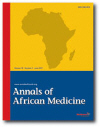
|
Annals of African Medicine
Annals of African Medicine Society
ISSN: 1596-3519
Vol. 8, No. 3, 2009, pp. 156-162
|
 Bioline Code: am09033
Bioline Code: am09033
Full paper language: English
Document type: Research Article
Document available free of charge
|
|
|
Annals of African Medicine, Vol. 8, No. 3, 2009, pp. 156-162
| en |
Blood pressure control and left ventricular hypertrophy in hypertensive Nigerians
Salako, Babatunde L; Ogah, Okechukwu S; Adebiyi, Adewole A; Oladapo, Olulola O; Aje, Akinyemi; Adebayo, Adedeji K; Ojji, Dike B; Ipadeola, Arinola & Nwafor, Chibuike E
Abstract
Background : Hypertension is a disease characterized by end-organ complications, leading to high morbidity and mortality in many cases. People with untreated or uncontrolled hypertension often run the risk of developing complications directly associated with the disease. Left ventricular hypertrophy (LVH) has been shown to be a significant risk factor for adverse outcomes both in patients with hypertension and in the general population. We investigated the prevalence and pattern of LVH in a treated hypertensive population at the University College Hospital, Ibadan, Nigeria, using non-hypertensive subjects as control.
Design and Setting : A prospective observational study performed at the University College Hospital, Ibadan, Nigeria.
Methods : Patients had 6 visits, when at least one blood pressure measurement was recorded for each hypertensive subject and average calculated for systolic blood pressure (SBP) and diastolic blood pressure (DBP) separately. The values obtained were used for stratification of the subjects into controlled and uncontrolled hypertension. Subjects also had echocardiograms to determine their left ventricular mass.
Results : LVH was found in 14 (18.2%) of the normotensive group, 40 (20.8%) of the uncontrolled hypertensive group and 14 (24.1%) of the controlled hypertensive group when left ventricular mass (LVM) was indexed to body surface area (BSA). When LVM was indexed to height, left ventricular hypertrophy was found in none of the subjects of the normotensive group, while it was found present in 43 (22.4%) and 14 (24.1%) subjects of the uncontrolled and controlled hypertensive groups, respectively. Significant difference in the prevalence of LVH was detected only when LVM was indexed to height alone.
Conclusion : Clinic blood pressure is an ineffective way of assessing BP control. Thus in apparently controlled hypertensive subjects, based on office blood pressure, cardiac structural changes do remain despite antihypertensive therapy. This population is still at risk of cardiovascular events.
Keywords
Blood pressure control, hypertension, left ventricular hypertrophy
|
| |
| fr |
Salako, Babatunde L; Ogah, Okechukwu S; Adebiyi, Adewole A; Oladapo, Olulola O; Aje, Akinyemi; Adebayo, Adedeji K; Ojji, Dike B; Ipadeola, Arinola & Nwafor, Chibuike E
Résumé
arrière-plan: l’hypertension est une maladie caractérisée par l’orgue de fi n complications menant à élevé de morbidité et mortalité dans de nombreux cas. Personnes avec l’hypertension non traitée ou non contrôlée souvent risquent de développer complications directement associées à la maladie. Laissé ventriculaire hypertrophie (LVH) a été démontré un facteur de risque signifi catif pour les effets négatifs résultats tant chez les patients atteints de l’hypertension et de la population générale. Nous avons a enquêté sur la prévalence et le modèle de LVH dans un traité hypertendues population au University College Hospital, à l’aide Ibadan, Nigeria non-hypertendues des sujets comme contrôle.
conception et la confi guration: A éventuel étude d’observation effectuée à la University College Hospital, Ibadan, Nigeria.
méthodes: Patients avaient six visites où au moins un sang mesure de pression a été enregistrée pour chaque sujet hypertendues et moyenne calculés séparément pour SBP et DBP. Les valeurs obtenues ont été utilisées pour stratifi cation des sujets dans l’hypertension contrôlée et incontrôlée. Sujets ont également echocardiograms pour déterminer leur masse ventriculaire gauche.
résultats: LVH a été trouvé en 14(18.2%) de la groupe normotensive, 40(20.8%) de groupe de hypertendues non contrôlées et 14(24.1%) de hypertendues contrôlée groupe lorsque quitté masse ventriculaire (LVM) a été indexée à corps surface (BSA). Lorsque LVM a été indexé à hauteur, laissé ventriculaire hypertrophie a été trouvé dans aucun du groupe normotensive, bien qu’il a été constaté présents dans les 43(22.4%) et 14(24.1%) de hypertendues non maîtrisée et contrôlée groupes respectivement. Était de différence signifi cative dans la prévalence de la LVH détectés uniquement lorsque LVM a été indexé à hauteur alone.
conclusion: clinique artérielle est un moyen ineffi cace de mesurer le contrôle de BP. Ainsi en sujet hypertendues apparemment contrôlée basée sur la pression artérielle de bureau, des changements structurels cardiaques restent malgré thérapie antihypertensive. Cette population est toujours à risque de maladies cardiovasculaires événements.
Mots Clés
contrôle de la pression sanguine, LVH, l’hypertension
|
| |
© Copyright 2009 Annals of African Medicine.
Alternative site location: http://www.annalsafrmed.org
|
|
